The effort to “go green” has been felt across all industries, as companies continue to evaluate the impact their operations have on the environment.
From using recycled or renewable resources to reducing energy consumption and waste, there seems to be a universal effort by businesses and consumers to protect our planet and do what we can to live a more sustainable lifestyle.
But we still have a ways to go.
The Green Consumer
According to a recent study from GreenPrint, consumers are seeking out environmentally friendly products with approximately 64% of Americans willing to pay more for sustainable items.
This is a ton of progress made seeing as though back in 2014, the perceived higher cost of environmentally-friendly products was the major holdup to consumers fully committing to a more sustainable lifestyle. The notion that eco-friendly products are always more expensive kept people from purchasing even though the want to be more green was there.
Now, the issue isn’t with price, but with the identification of eco-friendly products. 78% of Americans are ready and willing to purchase from eco-friendly companies, the problem is, they don’t know how to determine which companies are actually eco-friendly. Are the sustainable claims made by these companies true or is the “earth-friendly” label just a ruse?
Green Brand or Greenwashing?
Are brands actually helping the environment like they say they are? Or perhaps it’s greenwashing, where a company creates this eco-friendly facade with misleading information about their products and policies without actually being eco-friendly.
53% of consumers never or only sometimes believe a brand’s sustainability claims, and 45% need a third-party source to validate the claims before placing any trust in that company.
So businesses are faced with a lot of obstacles.
Not only are they figuring out the processes to implement in order to operate sustainably and reach an untapped audience, but they also have to provide clear evidence and third-party support in order to avoid eminent distrust from the public.
However, with the determination to stay sustainable and the want to be a trustworthy ally to your customers, becoming a more eco-friendly company is very simple.
Top Eco-Friendly Brands
The following brands have made environmental consciousness a major focus of their business and are succeeding on both the sales and consumer perception fronts. And if you haven’t considered incorporating environmentally-friendly products into your life, these companies might convince you to start.
Seventh Generation
Whether or not you’ve purchased a Seventh Generation product before, there’s no doubt you’ve encountered the brand on your latest trip down the laundry and cleaning aisles.
The company produces a variety of laundry detergents, soaps, and other cleaning products, as well as baby diapers, wipes, and more—and all in an environmentally conscious way. They use plant-based and recycled materials for all packaging, and they leave out any added fragrances or chemicals that could be harmful to consumers.
In 2016, the company launched the Come Clean initiative, which supported legislation that would require manufacturers of both consumer and industrial cleaning products to disclose all added ingredients on product labels and websites. This means those additives you probably can’t pronounce must be prominently featured on packaging so you’re aware of what you’re being exposed to. Since then, they’ve continued to advocate, support, and endorse numerous sustainability and ethics-based movements.
Their hashtag, #CleanWithPurpose, shows how their community comes together to share product recommendations, planet-friendly tips, photos and inspiration to live sustainably.
Seventh Generation also effectively breaks down the stereotype of the expense associated with eco-friendly products by pricing their items competitively with other brands—so you don’t have to spend significantly more to purchase products that are not only safe for the environment, but for your family and pets.
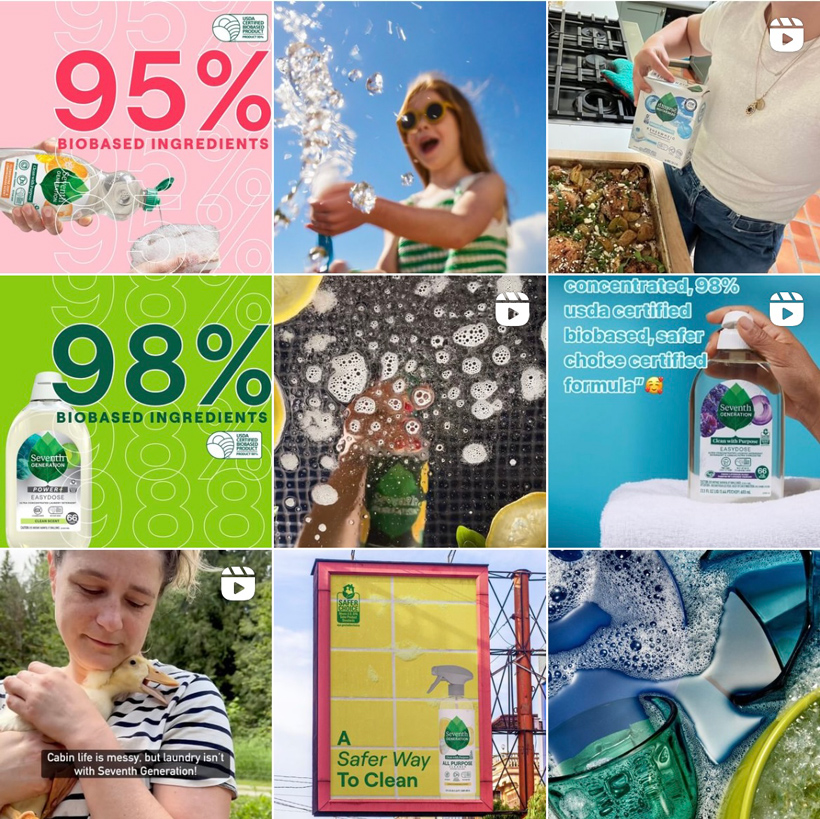
Seventh Generation’s efforts toward a more sustainable planet have not gone unrecognized, with several awards given to the company throughout the years for their leadership and dedication to change.
They are a B Corp Certified organization and produce a corporate consciousness report every year, with all previous impact reports transparent and always accessible to the public.
Seventh Generation puts the safety of their customers first, and is willing to take the time to research and develop quality products to meet today’s high standards.
Patagonia
Popular outdoor brand Patagonia isn’t just known for their durable outerwear; they’re also a major proponent of the Go Green movement.
What’s probably most admirable about the company is that they own up to the fact that not all of their products or processes are entirely eco-friendly. They admit that they have to use fossil fuels to produce the shell of their coats, but that they’re seeking out alternative energy sources to develop a more environmentally-friendly process.
In their Environmental Responsibility Program, they talk about accountability and future plans:
“As a company, we’ve never liked talking about things we’re going to do, only things we’ve done. We’ve made an exception for our climate goals, though, because we want everyone to hold us accountable.”
Being transparent about the fact that they are contributing to climate change, they support a variety of initiatives to reduce their carbon footprint and discover more sustainable ways to produce these high-quality products.
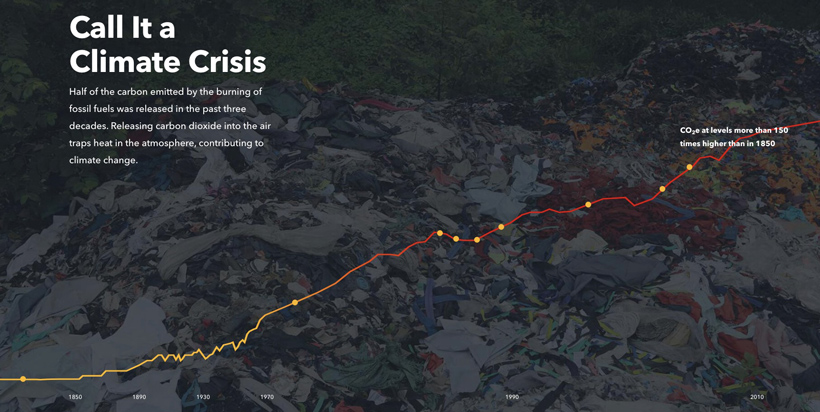
Since 1985, the company has pledged 1% of its sales to support environmental organizations around the world that take down dams, restore forests, protect endangered species, and promote sustainable agriculture practices.
And in 2002, Patagonia founder, Yvon Chouinard and Blue Ribbon Flies owner, Craig Matthews started 1% for the Planet, an alliance of businesses, nonprofits and individuals that donate 1% of annual sales or salary to environmental causes.
The company has big plans for the future, as well. By 2025 they plan to eliminate virgin petroleum material in their products and have packaging that is 100% renewable, reusable, home compostable, or easily recyclable.
Their biggest goal though? Reduce their absolute Scope 1, 2, and 3 emissions by 90% by 2024.
In addition to holding the brand accountable, customers and employees are strongly encouraged to get involved in their efforts to improve green practices as well.
They also have an eco-friendly return policy so customers can bring back any worn products to their stores to be reused or recycled.
Through Worn Wear, customers can discover resources for responsible care and repair of their Patagonia items, the reuse and resale program they run, and the recycling of a garment at the end of its lifespan.
P.S. Patagonia is also a B Corp Certified organization.
Chipotle
They know that sustainability matters to consumers as well as their own employees
When you think of fast food, you don’t normally think “sustainable.” But Chipotle may be the exception. Known for using only 53 real ingredients that are acquired through the most sustainable sources, the brand is continuously striving to create a future of real food for all.
They also announced this year that they’d be tying executive compensation to environmental, social and governance (ESG) goals. Though the numerous benefits of investing in Chipotle were already known, aka: contributing to a healthier world, it’s the investors that are now looking to support sustainable brands.
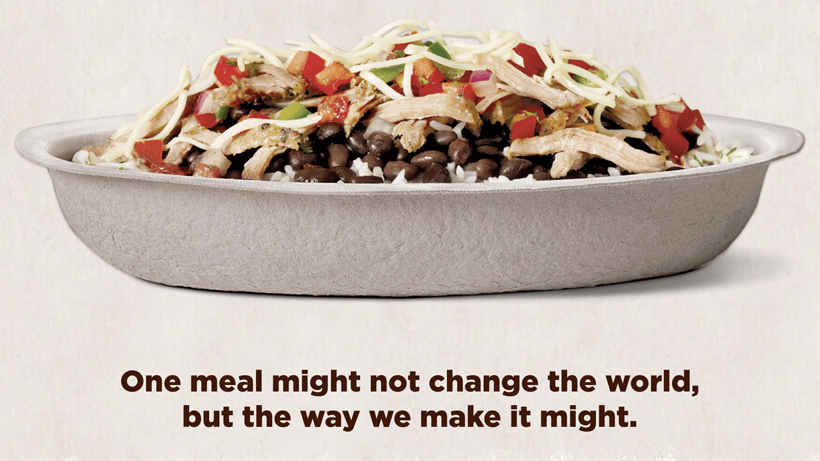
And Chipotle is giving every reason to invest.
According to their 2023 sustainability report, the brand has successfully set up and maintained composting programs at 32% of all their restaurants.
Additionally, 90% of all of their restaurants recycle, and 78% of all guest-facing packaging is designed to be recyclable, reusable or compostable.
Through their dedicated recycling, composting and waste-to-energy programs across their locations, Chipotle has kept their contributions to landfills at a minimum—diverting 399 million pounds of waste from landfills.
They first started their Gloves to Bags Program in 2019 when they recognized that 95% of their plastic gloves were going to landfills, “A waste blind spot for our industry,” as CEO Brian Niccol described it.
So now, Chipotle’s plastic gloves are up-cycled to plastic trash bags that are then used in their restaurants. But the innovation doesn’t stop there!
The brand also created a natural dye, sustainable clothing line within their merchandise. Using approximately 60,000 avocado pits to dye totes, tees, and sweatshirts, Chipotle was able to give their food scraps a second life and avoid toxic dyes that are normally found in the textile industry. And don’t worry, there is more naturally dyed merch to come in the future.Then, in the Fall of 2020, Chipotle launched Real Foodprint, a sustainability impact tracker for digital orders (which had largely become the driving force for revenue during the pandemic).
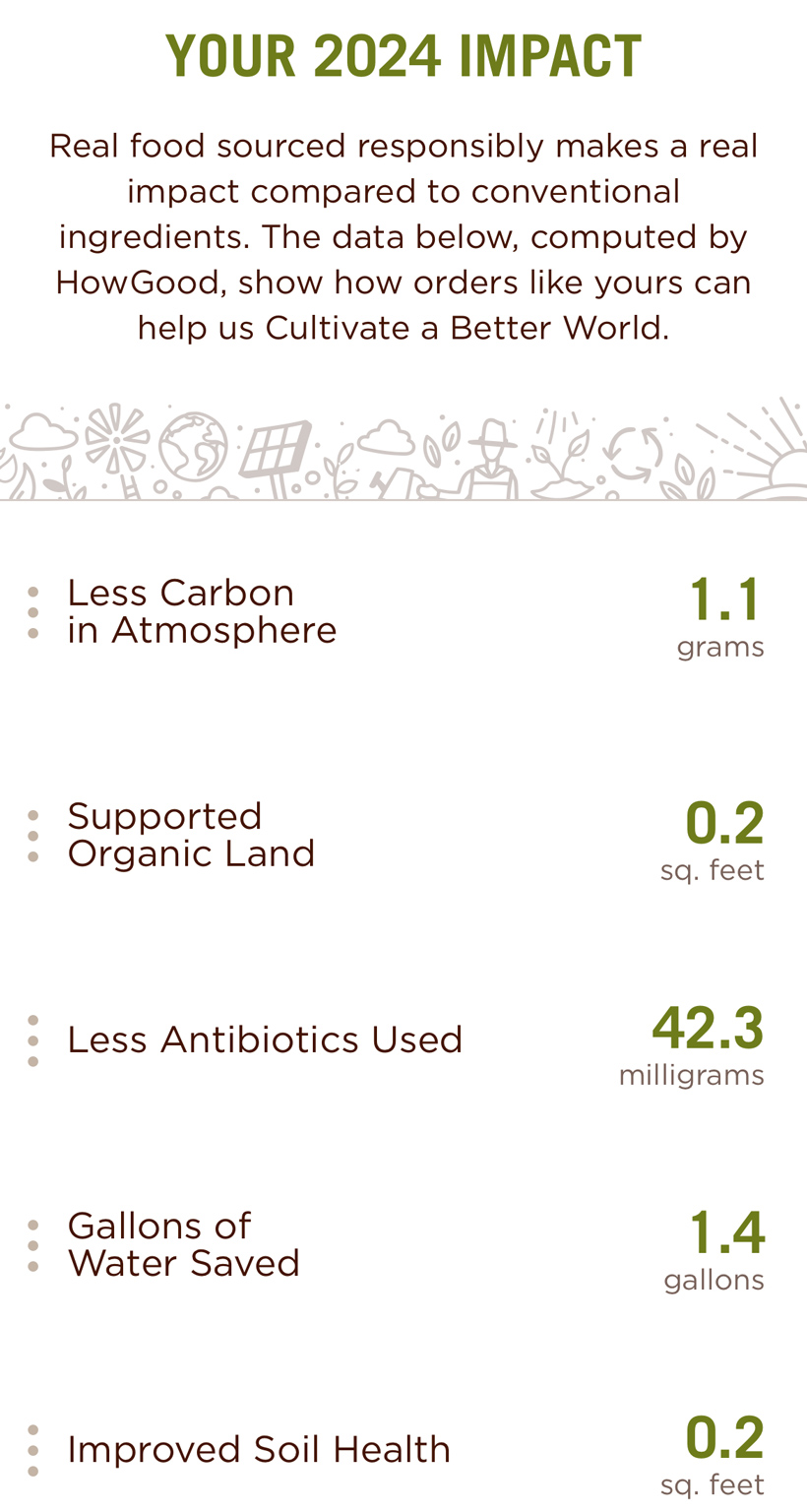
After every digital order placed through their app, customers were able to see the average impact that their Chipotle order made on the planet. For those who order from the app frequently, you’re able to see your entire impact over the course of the year!
Chipotle has accomplished a great deal of environmental initiatives, but there are still more to come in the future.
The brand is looking to introduce one new plant-based protein (in addition to their sofritas), achieve 100% third-party humane certification for all of their proteins, and further reduce waste by 5% by 2025—all of which they’re well on their way to.
Big goals to make a big impact. 👊
IKEA
Furniture and home goods giant IKEA utilizes a variety of renewable energy sources and waste management tactics to give back to our planet.
Through their sustainability strategy called “People & Planet Positive,” they believe that consumers shouldn’t have to choose between design, functionality, price, or sustainability when purchasing a product. Their product lines are not only manufactured through eco-friendly practices, but they encourage customers to live a more environmentally conscious lifestyle.
IKEA was the first major retailer to sell exclusively LED bulbs and lighting fixtures in their stores, and they utilize only these types of bulbs in their facilities. It installed one million solar panels on 370 of its buildings, built 535 wind turbines, and invested in two of the larger solar parks in the United States.
But this is only the beginning for IKEA.
IKEA is working towards 100% renewable energy through their wind farms and solar panels as well as sourcing wood from more sustainable locations, and have spent over $1 billion on these initiatives. In 2023, 97.8% of the wood used for their products was either FSC-certified or recycled.
The plan is to become a circular business and climate positive by 2030, and IKEA is doing a phenomenal job at showing what solutions we have in front of us. Now, all that’s left is for other companies to follow suit. From large corporations to small local businesses, everyone has the ability to make an impact.
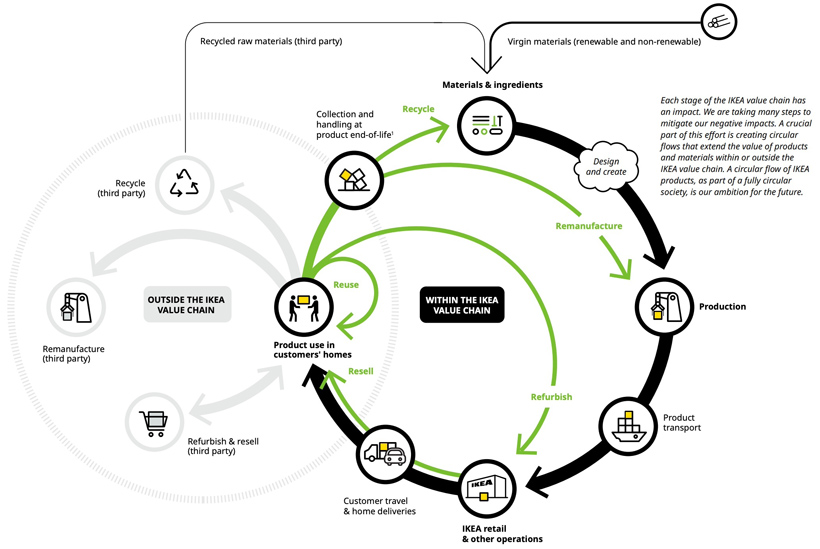
In March of 2021, IKEA won a Catalyst 2030 Award for their continuous efforts in collaborating with social entrepreneurs and creating a more sustainable planet. Catalyst 2030 is a movement that brings together social innovators and entrepreneurs from across the world that share in the common goal of attaining the Sustainable Development Goals by 2030.
Not to mention, they have been recognized multiple times throughout the years for their circular way of working to reduce environmental impact.
The Hershey Company
As a company that relies heavily on a product grown naturally around the world, The Hershey Company makes environmentally-friendly practices a top priority. From their manufacturing and distribution centers to their hotel and amusement park in Hershey, PA, the company has sought out as many ways as possible to keep their sustainability efforts in check.
Each of their locations has an Energy Champion tasked to implement the necessary changes and ensure all sustainability initiatives are moving forward.
They achieved a big milestone in early 2020, successfully transitioning to 100% certified sustainable cocoa, meaning the cocoa will be verified by independent auditors to ensure that it is grown in line with the highest labor, environmental, and farming standards.
In 2015, Hershey set a goal of reducing packaging weight by 25 million pounds by 2025. Well, they hit that goal 5 years early and are now determined to reduce packaging weight by an additional 25 million pounds by 2030.
But that’s just the beginning for their future sustainability plans.
By the end of 2022, Hershey is aiming to eliminate hard-to-recycle materials, and by 2030, they would like 100% of their plastic packaging to be recyclable, reusable, or compostable.
And they’re not claiming that it will be easy to do. A lot of obstacles stand in their way like commercial availability of materials, limited recycling infrastructure, cost, but they are actively using data and a wide array of tools to understand their packaging more and find the necessary solutions for them to achieve their goals.
Also by 2030, the company plans to reduce their absolute Scope 1 and Scope 2 greenhouse gas emissions by more than 50% and cut their absolute Scope 3 emissions by 25% compared to a 2018 baseline.
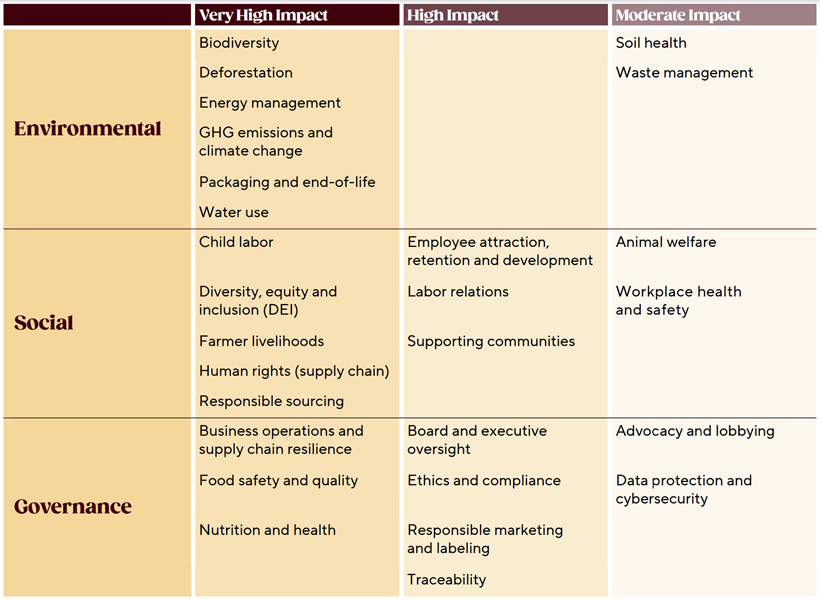
They are helping to fight deforestation in West Africa where poverty, absence of land titles and other root issues are affecting cocoa-growing regions. The company has helped farmers acquire land titles and adopt sustainable farming practices, while also distributing millions of tree seedlings to replace old cocoa trees.
The Hotel Hershey resort is a Silver LEED-certified building, and all light bulbs in the hotel and amusement park have been replaced with CFLs or LEDs.
Hershey tries to donate any items that others could have a use for instead of creating unnecessary waste. In addition to donating their own items, they sponsor drives, make financial donations, partner with various foundations and nonprofits, and make it a point to give back to their community. In 2014 they created the Hershey Community Garden—a space for the local community to grow, learn, and make an impact.
Community members can have their own plot, and attend the learning events Hershey hosts at the space.
Since its start, Hershey employees care for several plots, and donate their harvest. As a result, the garden has donated roughly 3,000 pounds of fresh produce to local food banks and nonprofits per year. In addition to donating produce, the garden grows and donates flowers to local nursing homes and hospitals.
Johnson & Johnson
Among these brands, Johnson & Johnson seems to be the most heavily-focused on internal operations to make sure sustainable practices are being adhered to.
The company’s Environment, Health, Safety, & Sustainability department monitors performance and compliance, and sets strict sustainability standards for the company. There are teams within this department that focus solely on product packaging, stewardship, and other key issues, and provide on-the-job training to employees in these areas.
They established a Management Awareness and Action Review System to review any potential environmental risks within the company through an annual assessment of their suppliers. This ensures that suppliers are compliant with waste management, employee safety, biosafety, fire prevention, and much more.
Johnson & Johnson’s sustainability plan is called Health for Humanity, which focuses on better health for all. They have established goals for 2025 that center around pandemics and epidemics, global health equity, people, the planet, and their brand partners.
By 2025, Johnson & Johnson wants to source 100% of their electricity from renewable sources. And by 2030, their goal is to achieve carbon neutrality for their operations and reduce absolute Scope 1 and 2 emissions by 44% from a 2021 baseline.
And they’re already making great strides toward their goals. In their 2023 Health for Humanity Report, they noted that 87% of their electricity is produced or procured from renewable energy sources, and their Scope 1 and 2 emissions are down 23% compared to their 2021 baseline.
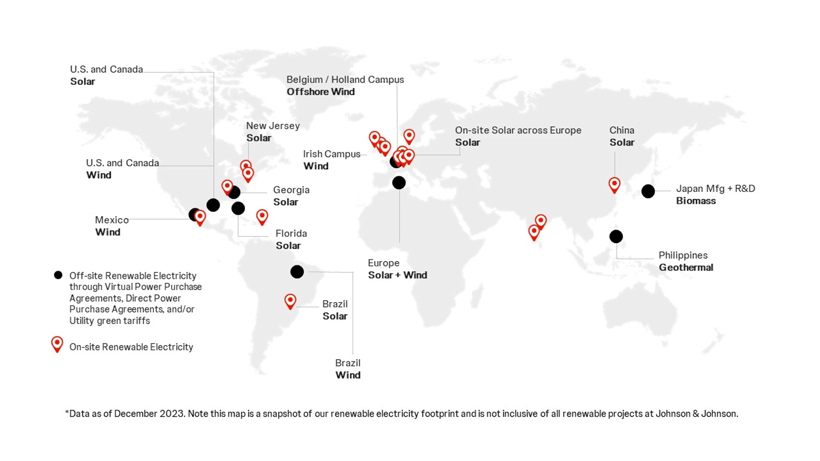
Currently, 89% of the company’s facilities are certified by the International Standards Organization’s (ISO) Environmental Management System and there are 62 LEED-certified buildings.
For product packaging, post-consumer recycled paper products are used whenever possible. To promote this initiative further, they developed the Responsibility Standard for Forest-Derived Materials in 2014 to prevent deforestation and encourage further use of post-consumer recycled materials. They have an ongoing effort to stop deforestation, and work with their suppliers, stakeholders, and partners to achieve a deforestation and conversion-free supply chain. By 2025, they hope to source 100% of their pulp, paper, and packaging from recycled materials, or from FSC, SFI or PEFC certified sources. Additionally, they plan to eliminate any fiber sourced from controversial sources, and ensure their suppliers adhere to their code of conduct.
Like some of these other brands, Johnson & Johnson has been repeatedly recognized for their sustainability efforts. In 2018, SC Johnson was recognized as a top user of green power by the U.S. Environmental Protection Agency and in 2020, they were given the Climate Leadership Award for Excellence in Greenhouse Gas (GHG) Management by The Center for Climate and Energy Solutions and The Climate Registry.
Join the Go Green Movement
From more eco-friendly packaging, to waste and energy reduction, to alternative energy sources, these top green brands are doing a lot—but that’s because they have the time and resources to strictly dedicate themselves to sustainability efforts.
As business owners and consumers, it’s important to consider how our purchases impact the environment and what eco-friendly alternatives are available to us. And while small businesses and individuals may not have the same time and budget as large corporations do, your choices still matter.
These green brands have set some great examples for other businesses to follow—so why not take a page out of their book? Then recycle it, of course 😉.
Here are a few simple changes you can make in your daily operations to make a difference today:
- Reduce single-use items: Enough with the coffee pods—go with a washable filter or traditional coffee maker. And instead of paper or plastic cups that just get thrown away, opt for ceramic mugs or tumblers that have a longer lifespan.
- Replace incandescent bulbs with LED: Using less energy than normal bulbs, LEDs can help reduce your carbon footprint and save you money in the long run. Bonus points if you’re able to rely on natural light only!
- Recycle: This one’s easy—recycle what you can’t reduce or reuse. Just be sure your employees are aware of the protocol and encourage them to be conscious of what they’re tossing in the trash.
- Opt for eco-friendly products: Whether it’s cleaning products or reusable paper towels, small swaps can make a big difference.
- Go paperless: Today, most everything can be done digitally. Encourage employees to opt for paperless methods such as email, electronic agreements, and file sharing—and save printing for items that absolutely need it.
As the powerful young activist Greta Thunberg once said, “I have learned you are never too small to make a difference.”
No matter the size of your business, no matter the size of the changes you make, your brand can have an impact.
By opting for more eco-friendly choices today, you can begin making a difference for a better tomorrow.
Editor’s Note: This post was originally published on May 17, 2016 and has been updated to provide you with today’s most relevant green brands.


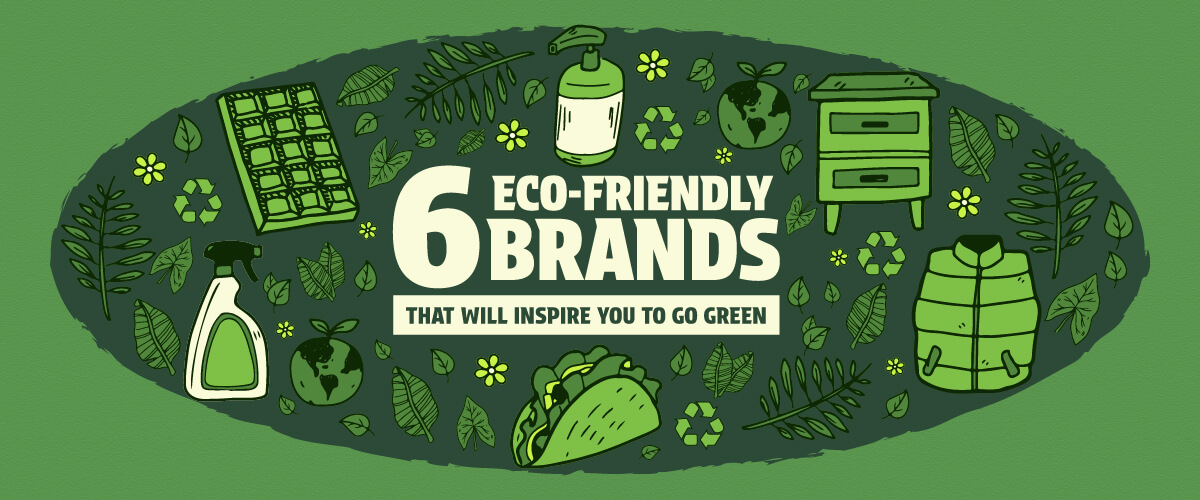


Hello, Mainstreethost Staff.
I just wanted to thank you for your blog about ecologically friendly products. Your article is informative and highlights firms that are doing good for the environment. The straightforward and informative writing style makes it easy to locate and support eco-friendly brands. Thank you for promoting sustainability and assisting in the development of a more environmentally friendly consumer world. Continue your excellent work